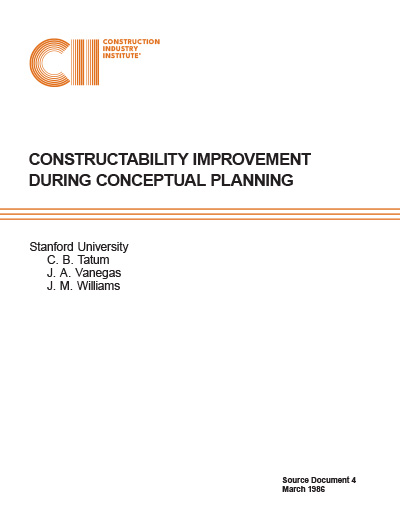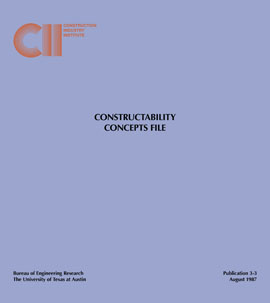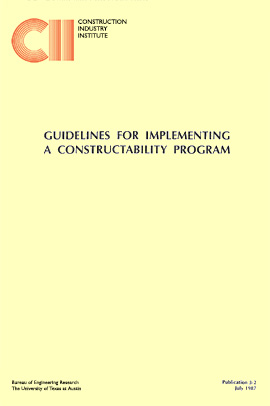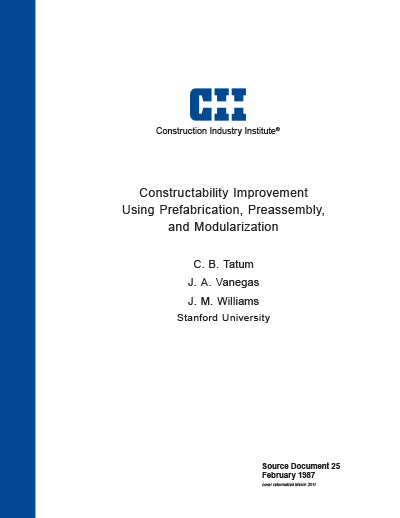
Constructability Improvement During Conceptual Planning, Version 1.1
Traditional approaches for completing many U.S. construction projects separate design and construction. This opposes many project objectives. It is neither advisable nor necessary. Manufacturers seeking growth or survival in today’s competitive markets cannot isolate production from product engineering. Similarly, owners seeking cost-effective construction of new facilities cannot neglect the opportunity of improved constructability. Neither can designers nor contractors seeking to remain competitive.
Constructability, the integration of construction expertise into all phases of a project, can benefit cost, schedule, quality, and other key objectives. As introduced in Chapter 1, constructability is not just review of completed drawings; it is not criticism of the designer; nor is it optimizing construction at the expense of other activities. Constructability involves thinking about how to build a project even before it is designed.
Many owners miss the opportunity for constructability improvement because they are not aware of the payback. There are exceptions. In this research we attempt to capture the experience of these progressive firms and to extend it to increase construction performance through constructability improvement. As described in Chapter II, our investigation included review of background literature, interviews with managers on 15 projects, analysis of this information to develop findings, and extending these to describe a process for improving constructability during the conceptual planning phase of a project.
Findings
This report presents the results of an investigation of ways to improve constructability during the conceptual planning phase of a project. This is when decisions have the highest influence on project cost. Chapter III reports our findings for three key constructability issues: the project plan, the site plan, and major construction methods. Our analysis for each of these issues included major concerns, approach used, and examples of improvements.
Constructability Improvement in Project Planning. – Meeting scheduled production dates or building occupancy dates was the major concern in developing the project plan on the projects we studied. Harsh weather, unusual site conditions, or tight schedules for completion tended to increase attention to the construction phase. Two approaches characterized the involvement of construction representatives in early project planning. Some were proactive; they selected construction methods, prepared plans, and persisted in obtaining the support from design and procurement necessary to implement these plans. In contrast, others responded to design initiatives by estimating the cost and schedule impacts. Many projects used a “backward pass” approach for planning, starting with required dates for completion and testing, to establish milestones for construction, engineering, and procurement.
We found two types of benefits from construction involvement in early planning. First, improved constructability results from increased design and procurement support for construction. The plan is better. Second, changes in the design (relatively easy to make in the conceptual phase) can avoid potential constructability problems. The design is easier to build.
Site Layout – Process considerations dominated site layout for the industrial projects we studied; function and optimal space utilization controlled building site layout. Construction representatives completed special studies, such as access routes, laydown areas, crane locations, and shoring requirements for adjacent buildings, to develop construction input to the site layout. On many of the projects these inputs resulted in providing essential space and access routes for efficient construction, despite high costs of site development. The overall cost savings which resulted probably would not have happened otherwise.
Major Construction Methods – Necessity and cost drove attention to construction methods on the projects we studied. Necessity generally meant developing special methods to meet unusual requirements, such as adverse weather or congestion imposed by existing facilities. Reducing site labor was another key concern on the industrial projects. Cost concerns brought attention to construction methods during initial estimates to determine project feasibility. Evaluating alternate structural and architectural materials to decrease costs led to examination of associated construction methods on several buildings. The approach used for evaluating major construction methods generally involved special studies or estimates. These frequently required iteration with the design criteria, approach, or configuration.
Both the industrial and the building projects provided interesting examples of constructability improvement through early consideration of construction methods. These included: construction of access roads in frozen ground; use of permanent precast panels for shoring trenches; use of precast concrete foundations for major equipment; and testing modules in the fabrication yard.
General Findings
Our findings for each of the three issues indicate important opportunities for meeting project objectives through improved constructability. However, we also found many other examples of constructability improvement during conceptual planning, as reported in Chapter IV. We grouped these findings into five types of actions by managers who seek to improve constructability. First, they develop, maintain, and inculcate a strong commitment to increased cost effectiveness. They demand “more construction for the money.” Second, they use constructability to meet project objectives. This means finding ways to improve cost, schedule, and quality, and keeping these objectives in mind when pursuing function, reliability, and aesthetics.
Third, they bring construction aboard early. Insistence on doing this is a major consideration in the choice of an overall project organization and the commercial format of the contracts. Individual qualifications are important. Merely superintendents-between-jobs will not do; broadly-experienced personnel with a team approach are essential. Next, they plan with a passion. This is for two reasons: first to make intelligent inputs to design and argue effectively for construction needs; second, to be ready to construct. Finally, but very importantly, they insist on a receptive designer; one who asks for construction input, puts project priorities first while evaluating it, and plays team ball.
Our general findings included important steps to involve construction early in the project. Selecting an overall project organization and type of contracts which allow this is paramount. Focusing joint design and construction attention on key issues is also critical. This provides the greatest leverage for constructability improvement.
Improving Constructability
In Chapter V, we extended both findings from the three issues and the general findings to describe an overall approach for improving constructability during conceptual planning. This includes identifying differences in project context, selecting the contractual approach, making the team aware, and implementing constructability improvement. The process begins with identifying differences in the project which create opportunities for constructability improvement. Factors which may be significant include: project type, location, and ownership; project objectives; and unusual performance requirements in completing the project or challenging technical requirements.
Next, selecting the contractual approach is perhaps the most important decision in constructability improvement. The project organization and type of contracts determine the means of early construction involvement; effective design and construction integration is much harder under the traditional approaches. However, early construction representation from the owner, the designer, the construction manager, or a consultant are possible even under the traditional contractual approaches. Building the project team, recognizing the essential roles of the owner, the designer, and the construction representative in constructability improvement, follows from the contractual approach selected. Each member should share a team approach.
Two actions by managers accomplish the next step of making constructability a project concern. First, they use constructability to directly pursue cost, schedule, and quality objectives. Second, they adopt cost-effective approaches to pursue other projects objectives, such as function and aesthetics. Next, establishing a project situation which supports constructability improvement includes drawing attention to early cost influence and involving construction personnel in major decisions. Finally, implementing constructability improvement requires several actions: 1) establishing a program (formal or informal); 2) identifying important issues and studies to focus activities; 3) completing necessary pre-construction planning; 4) building an interface with design; 5) reviewing the results; and 6) resolving conflicts.
Tailored to fit the scope and needs of individual projects, this overall approach can improve constructability. In turn, this supports other project objectives. Many benefits result. As in manufacturing, we can design the constructed product much better if we first think about how to build it. To realize the opportunities for constructability improvement, owners must insist on it; contractors must compete on it.
Constructability involves thinking about how to build a project even before it is designed. Maximum benefits occur when people with construction knowledge and experience become involved at the very beginning of a project. Three constructability issues that have the greatest impact during the conceptual planning phase of a project are the project plan, the site plan, and major construction methods.
In addition, industry tends to separate the functions of design and construction in capital projects. Design tends to place emphasis on minimizing its costs. Construction focuses on minimizing field costs. Fine-tuning the individual parts, however, does not yield the most successful project. Constructability integrates these parts and is one of the most powerful tools owners can use on capital projects. (SD-4, p. ii)



